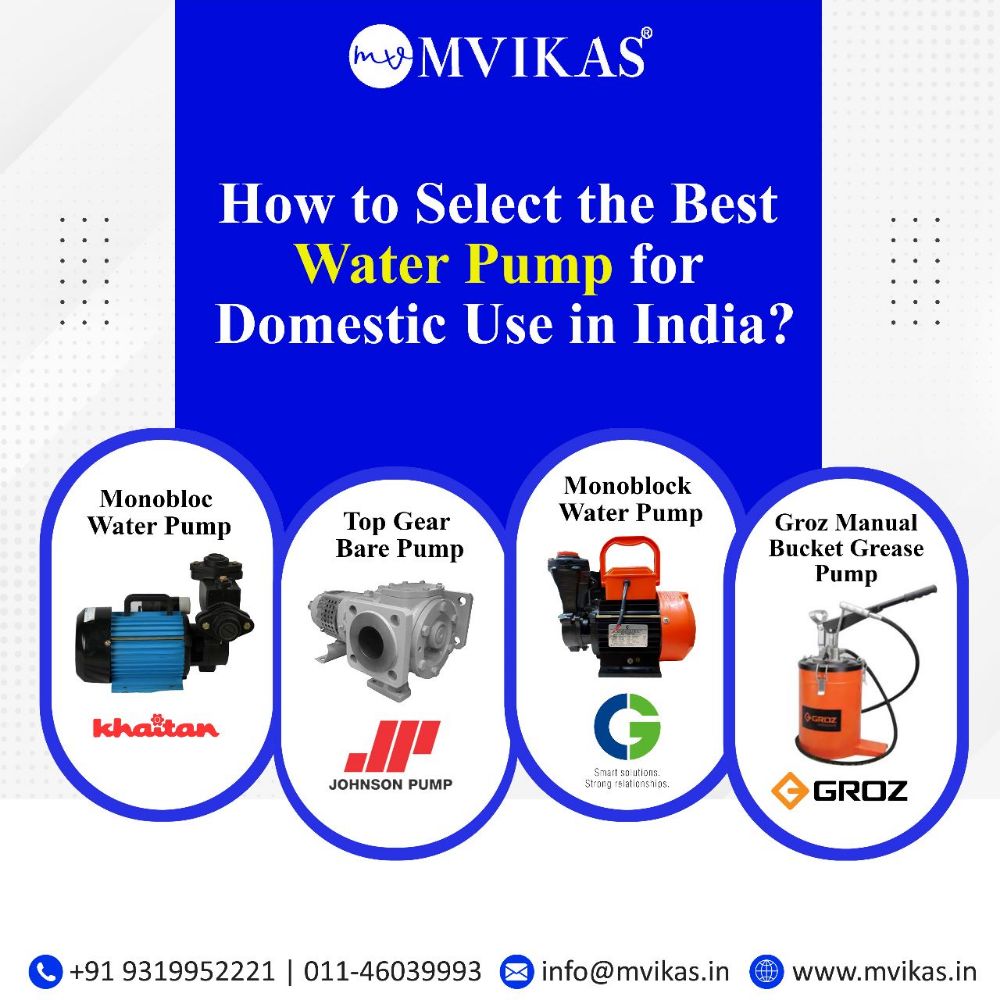Reachable at 9560662883  011-46039993 (Ext. 21 to 32) (10am - 06pm)
011-46039993 (Ext. 21 to 32) (10am - 06pm)
How To Select The Best Water Pump for Domestic Use in India?

To select a pump that matches your requirements, you must first establish its qualities based on its intended usage. To begin, you must establish what medium will be conveyed to minimize corrosion phenomena and hence premature pump wear. It is consequently necessary to understand the chemical composition of the medium to be pumped, its consistency, and the presence of solid components.
Importance of Water Pumping
Water pumps increase the irrigation efficiency by giving the right amount of water to each part of the field to accelerate cultivation. Low maintenance is required since they have fewer moving components, making the job easier. They are an essential tool for various household, light commercial and agricultural operations and may be instrumental in remote locations.
A water pump drains water from a basement or shallow flooded regions to drain and fill a swimming pool or dam or provide agricultural irrigation.
What factors should you consider while buying a water pump?
You must examine various things, just like you would when selecting any other product, to purchase the ideal one. The following are five aspects to consider while selecting the best water pump in India:
- Quality of the Pump
The first thing to look for is the brand of the water pump. The engine or motor can also tell you about the quality of the pump. Conduct the necessary research and surveys to assess a water pump's quality. Installing a long-lasting submersible pump at home is critical for ensuring consistent water flow for various household functions.
A reliable submersible pump for household use is ideal for generating the necessary water pressure to draw water from a borehole, irrigate a lawn, and much more.
- Flow Rate
The flow rate is the volume of fluid that travels through a specific cross-sectional area per unit of time. Accurate flow rate measurement with a suitable flow meter is vital to maintain fluid control systems work smoothly, safely, and efficiently. When choosing a pump, the flow rate is one of the essential elements to consider. It expresses how much water the pump can move in a particular amount of time in cubic meters per hour (m3/h).
More energy is required to push more water. A centrifugal pump is not positive acting; it does not constantly pump the same volume. The flow from the pump decreases as the depth of the water increases. Furthermore, the more it pumps against increasing pressure, the less it pumps. The PSI rating of a pump is essential because it signifies that it was built with materials and intended to withstand a specified pressure level.
On the other hand, Pump operators should be equally concerned with the flow rate of a pump, which defines how much you want to dispense, spray, or inject.
- The Size of Intel
Pump size is vital for ensuring the proper flow rate and differential head necessary for the application, which is the two most significant specifications when building a pump system. Flow rate, also known as volumetric flow rate (Q), is the amount of fluid that moves through a cross-sectional area in a given time. The pressure available where the suction pipe meets the booster pump is called inlet pressure, also known as pump intake pressure.
If the booster pulls from a break tank, the water supplier's pressure or the pressure generated determines entrance pressure. If the pump is inadequate in terms of power, the system will achieve a lower flow rate than necessary, adding extra pumps or system modifications. Oversizing pumps beyond a safety factor could result in a motor loaded at less than 50% of the entire load throughout the operation, causing the engine to generate a reduced power factor, thereby increasing running costs.
Because the suction port is low pressure, the density of water is low, and the flow velocity is sluggish, the pump's input is often more significant than the output. According to estimates in the process sector, this costs corporations billions of dollars each year.
- Maximum Head and Pressure
Max Head is the ability of a pump to propel the water upwards (also known as vertical lift'). People frequently need to pay more attention to the pump providing zero flow at its maximum head elevation!
What about the 'Maximal Flow Rate'?
The maximum flow rate of a pump refers to its capacity to transfer fluid volume. A pump's head is the highest point at which it can pump against gravity. Intuitively, a pump with more pressure may pump water higher and provide a higher head. The simplest example is a vertical pipe straightening from the discharge outlet. The point at which no force is called the "maximum head." Implying that your access points must be substantially lower than the maximum head.
Otherwise, water will not flow from your taps. The more pressure you have, the higher the head of water you need to pump. The greater the head, the higher the pressure (measured in PSI or CPA). The higher the pressure in a system, the more water it can convey. Head, like pressure, quantifies the kinetic energy transmitted from the pump to the liquid, but unlike anxiety, it depends on volume. Hence it is independent of the pumped fluid's specific weight.
- Pumping the type of Water
The sort of water you intend to pump is also an important consideration. Transfer pumps are different from firefighting pumps. Chemical pumps and garbage pumps are two more sorts of pumps.
CONCLUSION
When purchasing a water pump, it is essential to examine many criteria to ensure that you buy a model that will work for you. Among these considerations are the water pump's quality, the type of water pumped, the flow rate of the water pump, its entire head, and the size of its intake valve.




Leave your comment